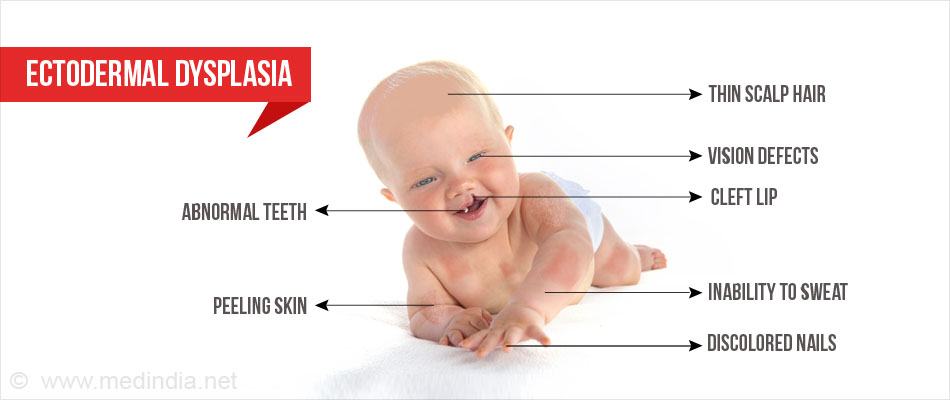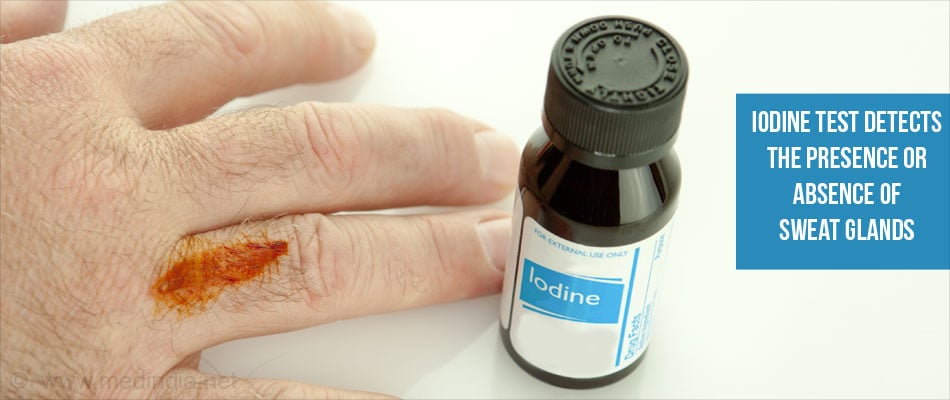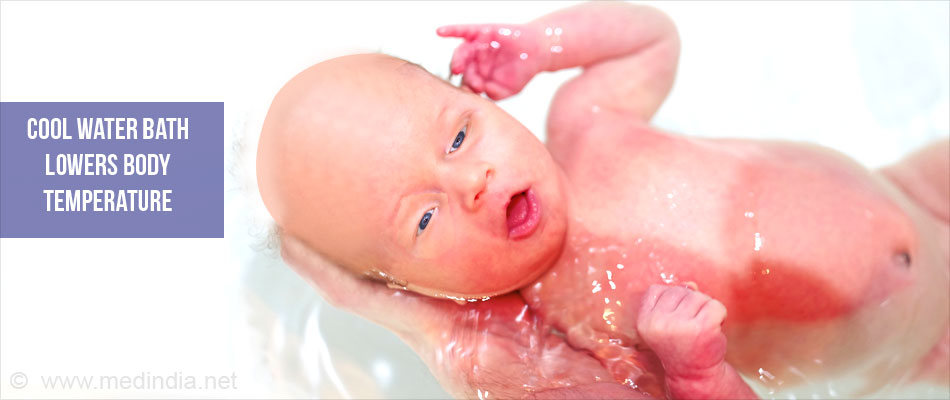- Possible New Treatment for Ectodermal Dysplasia Through Research at Greenwood Genetic Center - (https://globalgenes.org/raredaily/possible-new-treatment-for-ectodermal-dysplasia-through-research-at-greenwood-genetic-center/)
- Ectodermal dysplasia - (http://www.dermnetnz.org/hair-nails-sweat/ectodermal-dysplasia.html)
- About Ectodermal dysplasia - (https://www.nlm.nih.gov/medlineplus/ency/article/001469.htm)
- Hypohidrotic Ectodermal Dysplasia - (http://rarediseases.org/rare-diseases/hypohidrotic-ectodermal-dysplasia/)
- Sushma N Ramraje et al; Anhidrotic Ectodermal Dysplasia-A Report of Two Cases; Bombay Hospital Journal,Vol.51,No 2, 2009. - (http://www.bhj.org.in/journal/2009_5102_april/download/pg288-290.pdf)
- What is an ectodermal dysplasia? - (http://www.geneskin.org/ectodermal-dysplasis.aspx)
What is Ectodermal Dysplasia?
The term Ectodermal Dysplasias (ED) is used to describe inherited defects present at or just after birth, in which the body’s ectodermal structures fail to grow properly.
The ectoderm or the outermost layer of the human embryo contributes to the formation of the teeth, hair, nails, lens and retina of the eye, and sweat glands. The development of these structures gets affected in ectodermal dysplasias. The incidence of ectodermal dysplasias is high and is estimated to be about 7 cases per 10,000 births.

What are the Types of Ectodermal Dysplasias?
There are around 150 types of ectodermal dysplasias that are classified in several different ways. They are sometimes classified by the inheritance pattern (autosomal dominant, autosomal recessive, or X-linked) or according to the ectodermal structures involved i.e. hair, teeth, nails, and sweat glands. Some of the ectodermal dysplasias are listed below:
- Hypohidrotic Ectodermal Dysplasia (HED) - This is the most common type of ectodermal dysplasia. Persons with HED have a reduced ability to sweat because they have fewer sweat glands than normal or their sweat glands do not function properly. The condition is exclusively manifested in males, though some females may have less severe symptoms.
- Clouston's Hidrotic Ectodermal Dysplasia - Also called as Clouston syndrome, this condition is characterized by partial or total
- Alopecia (Absence of Hair), dystrophy of the nails, and darkening of the skin especially over the joints. The sweat glands are normal in this type of ectodermal dysplasia.
- Ectrodactyly-Ectodermal Defects (EEC) - Also known as Cleft Syndrome, EEC is characterized by a congenital absence of some of the fingers or toes, other features of ectodermal dysplasia, and cleft lip or palate.
- Focal Dermal Hypoplasia (FDH) - Also known as Goltz syndrome, manifestations of this condition include yellow-pink bumps on the skin and pigmentation changes.
What are the Causes of Ectodermal Dysplasias?
Ectodermal dysplasias are likely to be caused by a defect in the DNA or genetic mutation. This could be inherited from one or both parents, or may occur without any family history of the condition. The pattern of inheritance differs for the different types of ectodermal dysplasias. The most common type of ectodermal dysplasia, hypohidrotic ectodermal dysplasia (HED) is caused by a mutation in the ectodysplasin-A (EDA) gene. The mutated EDA gene disrupts the normal structure and function of a number of ectodermal structures.
What are the Symptoms of Ectodermal Dysplasias?
- The physical abnormalities that are expressed in different types of ectodermal dysplasias vary considerably. Some of the symptoms include: an inability to sweat or decreased sweating because of lack of sweat glands, resulting in a difficulty in controlling the body temperature
- Fragile, and thin hair, which may be coarse or coiled in some individuals
- Abnormal or missing teeth, teeth enamel defects with increased susceptibility to cavities

- Distorted, discolored or absent nails
- Abnormal skin pigmentation and skin peeling
- Large forehead
- Low nasal bridge
- Learning disabilities
- Hearing loss
- Vision defects with decreased tear production
- Cleft lip or palate
How do you Diagnose Ectodermal Dysplasias?
Other than the obvious features noted on physical examination, the following diagnostic tests may be performed to diagnose and confirm the presence of ectodermal dysplasias:
- Biopsy of the skin of the palm to confirm the absence of sweat glands. Biopsy of the mucous membranes is also obtained.
- A test using iodine to detect the presence or absence of sweat glands especially in those females who have only 1 defective gene for X-linked HED (2 defective genes are necessary for all the symptoms of the disease to be apparent). The test consists of the application of an iodine-in-alcohol solution over the entire back. It is then followed by the application of a corn starch/castor oil suspension. The sweat glands thus become highlighted and appear as black dots. Characteristic streaks appear on the back specifying those areas that are devoid of sweat glands.

- Iontophoresis Method – In this method, the sweat glands are stimulated by a drug called pilocarpine through the use of direct current (iontophoresis). The resulting perspiration is measured and analyzed.
- Dental x-rays to verify if the teeth are affected. The absence of certain teeth or developmental abnormalities in teeth help to confirm a diagnosis of HED.
- Molecular testing can be performed for mutations in the specific genes. The DNA can be isolated from blood cells and then screened for mutations.
How do you Treat Ectodermal Dysplasias?
Unfortunately, there is no specific treatment or cure for ectodermal dysplasias. Treatment involves controlling the symptoms and improving the comfort of the patient. The following tips are suggested if you suffer from ectodermal dysplasia:
- Wear a wig and dentures to improve your appearance.
- Use artificial tears to replace the normal tearing of the eyes which is otherwise affected.
- Keep your nostrils clear with a saline nose spray in order to remove debris from the nose.
- Patients with abnormal or no sweat gland function should preferably live in cool climatic conditions and take regular cooling water baths to maintain a normal body temperature.

- Special attention must be paid to children with sweating and mucous production abnormalities.
- A recombinant protein administered in the first month of life to babies with ectodermal dysplasias to lead to the proper development of hair, teeth and sweat glands is being studied. The current results of the study are however discouraging.
Health Tips
- Go for a complete dental evaluation at least twice a year.
- Try to keep yourself in a cool environment. Your workplace, home and school should be properly air-conditioned.
- Go for genetic counseling sessions if you are planning a baby and the condition runs in your family.
- Proper skin care and monitoring for signs of infection in patients with chronic scalp dermatitis and erosions should be done.
 MEDINDIA
MEDINDIA
 Email
Email






